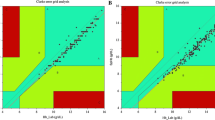Abstract
The pulse CO-Oximeter (Radical-7; Masimo Corp., Irvine, CA) is a multi-wavelength spectrophotometric method for noninvasive continuous monitoring of hemoglobin (SpHb). Because evaluating the relative change in blood volume (ΔBV) is crucial to avoid hypovolemia and hypotension during hemodialysis, it would be of great clinical benefit if ΔBV could be estimated by measurement of SpHb during hemodialysis. The capability of the pulse CO-Oximeter to monitor ΔBV depends on the relative trending accuracy of SpHb. The purpose of the current study was to evaluate the relative trending accuracy of SpHb by the pulse CO-Oximeter using Crit-Line as a reference device. In 12 patients who received hemodialysis (total 22 sessions) in the intensive care unit, ΔBV was determined from SpHb. Relative changes in blood volume determined from SpHb were calculated according to the equation: ΔBV(SpHb) = [starting SpHb]/[current SpHb] − 1. The absolute values of SpHb and hematocrit measured by Crit-Line (CL-Hct) showed poor correlation. On the contrary, linear regression analysis showed good correlation between ΔBV(SpHb) and the relative change in blood volume measured by Crit-Line [ΔBV(CL-Hct)] (r = 0.83; P ≤ 0.001). Bland–Altman analysis also revealed good agreement between ΔBV(SpHb) and ΔBV(CL-Hct) (bias, −0.77 %; precision, 3.41 %). Polar plot analysis revealed good relative trending accuracy of SpHb with an angular bias of 4.1° and radial limits of agreement of 24.4° (upper) and −16.2° (lower). The results of the current study indicate that SpHb measurement with the pulse CO-Oximeter has good relative trending accuracy.




Similar content being viewed by others
References
Bagshaw SM, Brophy PD, Cruz D, Ronco C. Fluid balance as a biomarker: impact of fluid overload on outcome in critically ill patients with acute kidney injury. Crit Care. 2008;12(4):169.
Payen D, de Pont AC, Sakr Y, Spies C, Reinhart K, Vincent JL. A positive fluid balance is associated with a worse outcome in patients with acute renal failure. Crit Care. 2008;12(3):R74.
Locatelli F, Buoncristiani U, Canaud B, Kohler H, Petitclerc T, Zucchelli P. Haemodialysis with on-line monitoring equipment: tools or toys? Nephrol Dial Transpl. 2005;20(1):22–33.
Garzoni D, Keusch G, Kleinoeder T, Martin H, Dhondt A, Cremaschi L, Tatsis E, Ibrahim N, Boer W, Kuehne S, Claus M, Zahn M, Schuemann E, Engelmann J, Hickstein H, Wojke R, Gauly A, Passlick-Deetjen J. Reduced complications during hemodialysis by automatic blood volume controlled ultrafiltration. Int J Artif Organs. 2007;30(1):16–24.
Steuer RR, Harris DH, Conis JM. A new optical technique for monitoring hematocrit and circulating blood volume: its application in renal dialysis. Dial Transplant. 1993;22(5):260–5.
Shamir MY, Avramovich A, Smaka T. The current status of continuous noninvasive measurement of total, carboxy, and methemoglobin concentration. Anesth Analg. 2012;114(5):972–8.
Critchley LA, Lee A, Ho AM. A critical review of the ability of continuous cardiac output monitors to measure trends in cardiac output. Anesth Analg. 2010;111(5):1180–92.
Dasselaar JJ, Huisman RM, DE Jong PE, Franssen CF. Relative blood volume measurements during hemodialysis: comparisons between three noninvasive devices. Hemodial Int. 2007;11(4):448–55.
Lamhaut L, Apriotesei R, Combes X, Lejay M, Carli P, Vivien B. Comparison of the accuracy of noninvasive hemoglobin monitoring by spectrophotometry (SpHb) and HemoCue(R) with automated laboratory hemoglobin measurement. Anesthesiology. 2011;115(3):548–54.
Macknet MR, Allard M, Applegate 2nd RL, Rook J. The accuracy of noninvasive and continuous total hemoglobin measurement by pulse CO-oximetry in human subjects undergoing hemodilution. Anesth Analg. 2010;111(6):1424–6.
Colquhoun DA, Forkin KT, Durieux ME, Thiele RH. Ability of the Masimo pulse CO-Oximeter to detect changes in hemoglobin. J Clin Monit Comput. 2012;26(2):69–73.
Frasca D, Dahyot-Fizelier C, Catherine K, Levrat Q, Debaene B, Mimoz O. Accuracy of a continuous noninvasive hemoglobin monitor in intensive care unit patients. Crit Care Med. 2011;39(10):2277–82.
Critchley LA, Yang XX, Lee A. Assessment of trending ability of cardiac output monitors by polar plot methodology. J Cardiothorac Vasc Anesth. 2011;25(3):536–46.
Giraud B, Frasca D, Debaene B, Mimoz O. Comparison of haemoglobin measurement methods in the operating theatre. Br J Anaesth. 2013;111(6):946–54.
Mitra S, Chamney P, Greenwood R, Farrington K. The relationship between systemic and whole-body hematocrit is not constant during ultrafiltration on hemodialysis. J Am Soc Nephrol. 2004;15(2):463–9.
Booth J, Pinney J, Davenport A. Do changes in relative blood volume monitoring correlate to hemodialysis-associated hypotension? Nephron Clin Pract. 2011;117(3):c179–83.
Miller RD, Ward TA, Shiboski SC, Cohen NH. A comparison of three methods of hemoglobin monitoring in patients undergoing spine surgery. Anesth Analg. 2011;112(4):858–63.
Conflict of interest
The authors declare that they have no conflicts of interest.
Author information
Authors and Affiliations
Corresponding author
Rights and permissions
About this article
Cite this article
Yamada, H., Saeki, M., Ito, J. et al. The relative trending accuracy of noninvasive continuous hemoglobin monitoring during hemodialysis in critically ill patients. J Clin Monit Comput 29, 107–112 (2015). https://doi.org/10.1007/s10877-014-9574-6
Received:
Accepted:
Published:
Issue Date:
DOI: https://doi.org/10.1007/s10877-014-9574-6




